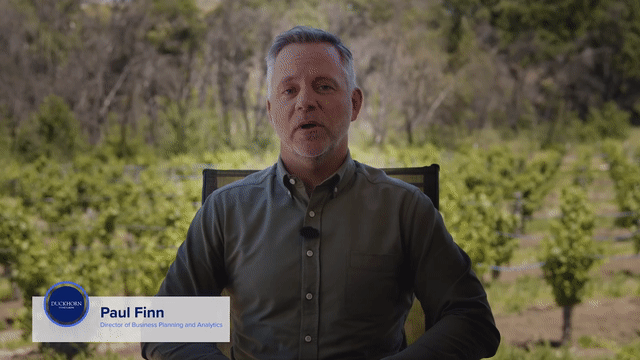
By leveraging Anaplan, we’re able to get one source of truth and we can collaborate in real time and make meaningful decisions about our business.— Paul Finn, Director of Business Planning and Analytics, The Duckhorn Portfolio
Accessible, granular, reliable
financial and supply data for 10 brands, 150+ labels
Enhanced collaboration
and time savings with connected data and consistent planning processes
Agile purchasing
and detailed, timely COGS data, even during busy harvest months
Building upon a groundbreaking IPO, Napa Valley–based premium winemaker The Duckhorn Portfolio has created a Connected Planning environment that blends finance, supply chain, and sales planning into a cohesive system that saves time and money, increases transparency and agility, builds collaborative relationships across and between teams, and ultimately helps produce sought-after wines and loyal customers.
Humans have made wine for thousands of years, but vintners today face 21st-century challenges like any business, including intense competition, unforeseen disruptive events, and evolving paths to reach customers.
When The Duckhorn Portfolio had its initial public offering in 2021 (NYSE: NAPA), all of those factors were at play, and the company needed to explain that to investors. Paul Finn, Duckhorn’s Director of Business Planning and Analytics, remembers preparing for the IPO. “We needed a robust P&L, and wanted to manage our data in a dynamic way,” he recalls. “We chose Anaplan in 2019, and I'm very proud of how we leveraged it to go public. Using information we had in Anaplan, we were able to talk to Wall Street about the dynamics of our business and our differentiators.”
Connected Planning leads to confident decisions
The IPO was just one stage in Duckhorn’s Anaplan journey. With a dynamic P&L and connected historical financials as a foundation, the company added demand planning, sales planning, operational planning, CapEx planning, Cost of Goods Sold (COGS) planning, supply planning, and more to the Anaplan blend. The team also plans to build a three-statement model (income statement, balance sheet, and cash flow). “Because we bring that all together on one platform, we can predict the future in a much more dynamic and accurate way,” Finn says.
Data sources include Microsoft Dynamics NAV Enterprise Resource Planning (ERP) and several wine industry–specific applications. Most data is aggregated in Microsoft SQL Server then moved into Anaplan via CloudWorks. (For Duckhorn wisdom on data integration and technology concerns, see “Learning from growth,” below.)
Finn highlights the ability to “dimensionalize” Duckhorn’s data using Anaplan. That means planning for Duckhorn’s 10 brands (and counting) and multiple business units on one platform, retaining the ability to drill down to one brand or label, while simultaneously rolling data up to the corporate level. “We simply couldn't process as much data with our old systems as we do now with Anaplan,” Finn says, “We spend much less time scrutinizing and validating data, and we share information in real time with colleagues anywhere because Anaplan is a cloud application.”
The company has assembled a crew of talented in-house model-builders to cultivate its Anaplan environment, partnering with Twelve Consulting Group for best practices and guidance. “TwelveCG brings broad CPG expertise to a business like ours, and they've taken the time to understand what’s unique about the wine industry,” Finn says.
"The Duckhorn Portfolio exemplifies the perfect blend of enablement and innovation in their partnership with Anaplan and Twelve Consulting Group,” says Pete Amundson, Head of Growth at TwelveCG. “Their commitment to harnessing Anaplan's transformative capabilities across the business turns their plans into actionable insights."
Small decisions flow up to leadership
Anaplan solutions deliver value throughout Duckhorn. “Using Anaplan saves us immense amounts of time and improves our accuracy and insight,” Finn says. “We're getting better at how we do business because we work with better information.”
One example is COGS-driven gross margin. “In agriculture, we’re at the whims of nature, and sometimes we’re thrown a curveball like a wildfire,” Finn says. “So we gather yield information direct from vineyards into our COGS model in Anaplan to quickly calculate gross profit and margin.” (Learn more about Duckhorn’s grape planning in “Where artistry meets analysis,” below.) The company also uses Anaplan to plan bottle purchasing (prices rose 20% in 2022 alone) and to ensure that its most loyal customers get sought-after wines. (See how in “Cultivating long-term loyalty,” below).
“Some tasks or analyses we do in Anaplan may seem small or mundane, but they’re impactful for certain individuals,” Finn says. “Small decisions roll up and drive management choices that ripple across the organization. And ultimately, it all flows up to the C-Suite, where leaders make big decisions and answer to Wall Street.” Those big decisions include mergers and acquisitions that bolster Duckhorn’s growth. “We've taken on more M&A opportunities lately, and used Anaplan to understand how they will affect the business,” Finn notes. “By leveraging Anaplan, we’re able to get one source of truth and we can collaborate in real time and make meaningful decisions about our business.”
Connecting more than plans
The Duckhorn Portfolio is proud of its employee-centric culture — the company sometimes refers to its people as a “flock” — and Connected Planning complements that ethos. “One thing I really like about Anaplan is the relationships that it helps me create as we grow and evolve,” Finn says. “Using the same information on a cutting-edge platform builds trust. And when we trust each other, we build strong relationships, make good decisions together, and have fun along the way.”

Making and selling wine at The Duckhorn Portfolio requires constant balance. Skilled winemakers require specific grapes to produce beloved wines, but the vagaries of nature affect the quality and quantity of grapes available each year. Balancing those realities — while keeping in mind the financial results that will satisfy investors — is the work of Mary Basore, Vice President, Supply Planning at Duckhorn. She poetically calls it “applying data, analytics, and mathematics to artistry.”
In a decade at Duckhorn, Basore has seen the company’s portfolio double from five brands to 10, the number of labels grow to 150, and the total production increase fivefold. She turned to Anaplan to support that growth.
It all starts with grapes. Winemakers have three months in late summer to harvest and process a season’s grapes, but planning begins as long as three years in advance. Grapes for Duckhorn’s wines come from their own estate vineyards, supplemented by purchases from contract vineyards and the spot market. “We have very passionate people throughout the western states purchasing grapes,” Basore explains. “They always want the best grapes, but they need to get the right ones in the right quantity.”
That’s not easy, because production per acre can vary 20% from year to year. “When you’re talking 30,000 tons of grapes a year, 10% makes a huge difference,” Basore says, so Duckhorn’s experts visit each vineyard at least three times annually to estimate production. They enter that data in Anaplan.
These production estimates feed Basore’s Anaplan models for grape purchasing. “My team and I use Anaplan to determine the grapes we need to produce wines of the right quantity and quality to satisfy all of our brands,” she says. “Our Anaplan tools translate the business plan into a purchase plan for our grower reps.” When plans change — due to weather, unforeseen events like wildfires, or business activity like acquisitions — they quickly see the effects on their purchasing requirements and can react accordingly.
“We can immediately know how a change will affect our gross profit, all the way down to our margin,” says Paul Finn, The Duckhorn Portfolio’s Director of Business Planning and Analytics. “As a result, we can make on-the-fly decisions to ensure that our winemakers have exactly the quantity and quality of fruit they need to practice their art at the highest level.”
“Our main goal is to stay nimble,” Basore explains. “We want to stay ahead of the competition when we see trends emerging.”

When Erik Schau and Kaylaa Kawasaki joined The Duckhorn Portfolio, the company was already doing financial planning and sales planning in Anaplan — but Duckhorn wanted to do more. “Kaylaa and I were hired to expand how we use Anaplan,” Schau recalls. “Now we've got CapEx planning, OpEx planning, variable compensation, workforce planning, and more, all connecting to a Data Hub. We use Anaplan for everything.” Here are some lessons they learned in the process:
- Commit yourself: If you want to develop, maintain, and grow an Anaplan environment successfully, you need to have the right tools in place, the right people on your team, and the right support from leadership. “Establishing that commitment to the project is very important to the process,” Schau says.
- Build your talent base: The Duckhorn team works heavily with Twelve Consulting Group, and has cultivated staff model builders to move quickly and tailor solutions to Duckhorn’s vision. “Having model-builders on staff really turbocharges what we can do with Anaplan,” Schau says. “We can go from the idea stage to final UX dashboards in a matter of days.”
- Enable and support your team: The Anaplan Center of Excellence at Duckhorn is the first line of support for model builders and users throughout the company. “They don't have to look online or reach out to others,” Schau says. “We put them on the right track, or if they need more assistance we help them build exactly what they want.”
- Make it personal: Teams throughout Duckhorn work in Anaplan using their own specific terminology and processes, so data is presented in customized, task-specific formats. This doesn’t have to be a big lift; for example, an Anaplan UX page was tailored on the fly for a Duckhorn engineer building the budget for a capital project. “He was more confident in his decisions because of the data presentation,” recalls Paul Finn, Duckhorn’s Director of Business Planning and Analytics.
- Get under the hood: In addition to adding use cases, Schau and Kawasaki improved Duckhorn’s Anaplan architecture. “We literally tore down and rebuilt the Anaplan solution in a year,” Schau says. “It's much improved in terms of performance, efficiency, and model size.” Establishing hierarchies and transaction lists, having them in one place and in the right format, and building them in an efficient and optimized way improved the team’s ability to build all the other models.
- Take care of the plumbing: Data engineering and pipelining are important, and although Anaplan Cloudworks is Duckhorn’s primary integration tool, it’s not the only one. “We use every variety of data integration you can have with Anaplan, including Anaplan Connect and the RESTful API,” Schau says. “Each one is perfect for a different purpose.”
- Take pride in your accomplishments: “I'm most proud of the rebuild we did on our Data Hub,” Schau says when asked. “Having a very solid Data Hub at the core of our solution let us develop the spoke models exponentially faster than if we built all that information in each of the spoke models.”
It all adds up to a stimulating and satisfying work environment for teams across the company. “I love being able to plan and execute like we do,” Schau summarizes. “I think our work gives Duckhorn a competitive edge.”

Wines from The Duckhorn Portfolio are highly sought after, so the company has a lively direct-to-consumer (DTC) business — wine clubs, tasting rooms, and direct sales — in addition to retail sales, and goes the extra mile to ensure that individual customers are treated right. “We're very careful about how we sell directly to our consumers,” says Paul Finn, The Duckhorn Portfolio’s Director of Business Planning and Analytics. “We want to make sure that we please and delight them 100% of the time.”
That means allocating a portion of its most sought-after vintages for direct sales. “That's a complicated process,” Finn says. “People sign up in advance, but they have to wait their turn to buy and we can’t sell the wine until it’s time. We leverage Anaplan to allocate and track those wines. That way we can be sure everything is fair and accurate.”
With Anaplan, the Duckhorn team knows that inventory is on hand when each customer’s turn comes up. It takes extra effort, but it’s worth the investment to delight — and retain — its best customers. “The result of all of that hard work is that we have very loyal customers who consistently buy our wine for many years,” Finn says.
Paul Finn, Director of Business Planning & Analytics, The Duckhorn Portfolio: The Duckhorn Portfolio aims to serve wine wherever fine wine is poured. We make premium wine here in the Napa Valley.
Historically, it used to take us a few weeks or even a month or so to generate a forecast. With Anaplan, we can now do that in a few days. Especially being a public company, that's critical to our success.
Some of the key components that we use Anaplan for are our operating expense planning, our capital planning, our demand planning, and tying all of that together for a full P&L and even a three-statement.
One of the biggest challenges we had was many different data sources and sources of truth. By leveraging Anaplan, we're able to get one source of truth and we can collaborate in real time and make meaningful decisions about our business.
My name is Paul Finn. I'm the director of business planning and analytics. We plan with Anaplan.

